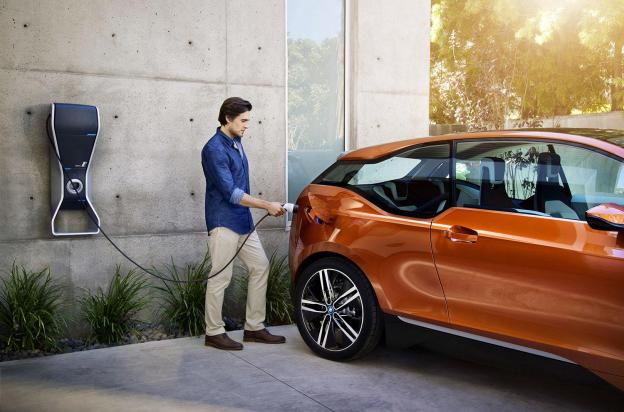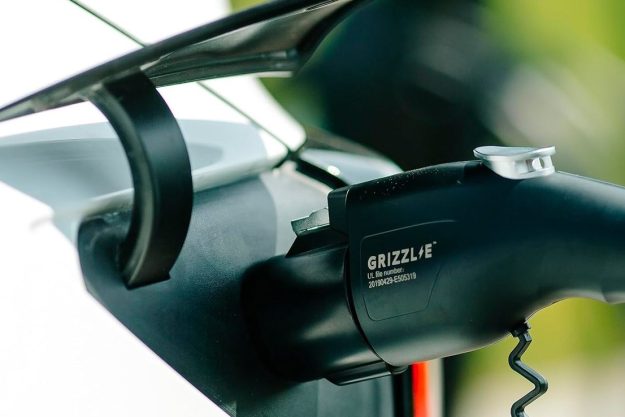
Congratulations, you just bought a fully electric car. You’re on the cutting edge, you’re an early adopter, you’re saving the world one fewer CO molecule at a time.
And good luck finding a place to charge it up.
Sure, you’ve got your 220-volt home charger that can fill that Leaf, Model S, Spark, i3 or other techno-wonder full of electrons in a few hours, but if you feel like driving to Florida (and you’re not already in Florida), you may have a problem: where do you charge up on the open road?
It may as well be 1913 again, when the owners of gas-powered vehicles like the Ford Model T bought jars of gasoline at the local store to power their horseless carriages. Yes, that is indeed how it worked. Stops were planned well ahead. So it goes for today’s EV-driving pioneers.
You might be be saying “just use one of those public chargers.” That’s simple enough for residents in greenie states on both American coastlines, but guess how many public charging stations there are in Wyoming: zero.
The software systems on which chargers currently operate are many and varied. As such, no standard really yet exists.
Your electric bill helps pay for the (still spendy) solar panels, wind turbines, hydro dams, nuclear power plants and all that nasty coal we burn to make our tech gadgets and now cars operate. At least the electrical infrastructure is already in place and adding vehicle chargers is cheap and easy compared to building gas stations. As the electric vehicle segment continues to expand, there will obviously be more demand for electricity.
But what would happen if Mercedes decided to build their own chargers no one else could use? What if Chevrolet did the same thing? Or Ford? Or BMW, Volvo, and Fiat? You’ll be able to hear the regenerative brakes squeal across the whole EV market.
A recent announcement by Tesla founder Elon Musk that his company was moving forward immediately with the installation of hundreds of solar-powered Supercharger facilities across the United States exclusively (and at no charge) for Tesla owners illustrates the two-steps backward problem facing the nascent EV industry: if you drive a Nissan Leaf and limp into a Tesla facility on E, start looking for an outlet where you can plug in an extension cord for the next 12 hours because you’ll get no love (or juice) from the Tesla chargers, even though the plug fits.
I can understand Musk’s rationale for keeping the chargers exclusive to his brand. After all, the cars are quite expensive and it’s a great way to keep his customers happy, moving – and loyal. And, he’s dropping some major cash to build out his private charging infrastructure. Why share? For the good of humanity? Hello, this is a business venture we’re talking about.
And while electric cars all use the same standardized J1772 charging connection just as gas-powered cars use the same filling nozzle, there is as yet no agreement on who is going to pay for all that the power, who will sell it, how much it will cost, how the billing will work, what the fees will be, what taxes there might be or what the answers are to dozens other logistical, political and financial questions. In a recent conversation with Digital Trends, Brett Hauser, CEO of GreenLots, a provider of back-end software technology used in many electric vehicle charging stations around the world, warned that there could be trouble on the horizon as demand rises for rapid charging of electric vehicles.

“We’re in a marathon, not a sprint,” Hauser said of the developing EV charging segment. “The infrastructure that was initially deployed using government funds was proprietary in nature” due to the contracts with the early players – mostly power providers – as EVs got rolling. Hauser is pushing hard for an “open standard ” when it comes to the software that runs charging stations. He’d like to see everyone, including car makers, power companies, charger makers and billing operators cooperate and figure out the details now while the game is young.
One example he cited regarding how things can go wrong took recently place in Maui, where Hauser said a company called Better Place set up dozens of chargers – and then left the EV charging business just months later, leaving behind expensive, nearly new but useless equipment that had to be completely replaced, rather than just needing to be reprogrammed. “If we have to spend new money replacing old infrastructure, we’re not going to get very far,” Hauser said.
Hauser did say he felt like the carmakers had done a good job so far coming up with a charging standard, but was less optimistic about other aspects of the process. He said he felt “consumer roaming” – going from charging station to charging station regardless of vehicle brand – was still far from figured out. Tesla’s move isn’t helping there either.
But his biggest caveat was on the more technical side. The software systems on which chargers currently operate are many and varied. As such, no standard really yet exists. Of course, he’d like GreenLots back end systems to be that standard but insists he also wants it to be an “open standard” software approach that evolves along with the infrastructure.
No one likes the spectre of government intervention, but… some sort of oversight may be needed to keep the EV segment moving forward.
“It’s the responsibility of stakeholders from the DOE [Department of Energy], the state government agencies, municipalities and utilities to stand up and mandate that open standards are required,” he said. But he added that he’s heartened by what he’s seen so far. “Everyone wants to do what’s right for the industry and see it grow.” He said he thinks the DOE and other interested entities are “receptive to open standards” and are looking to past European growing pains to try and avoid pitfalls in the US as the segment grows.
He said open standards for the software that operates chargers is required for companies looking to bid on charger installation and operation contracts in many Euro states. “And I think we’re actually moving that way here in the United States,” Hauser said. But we’re not there yet.
Mike Tinskey, Ford’s top EV and infrastructure exec, was also optimistic. In Portland recently while touring around some of Ford’s latest electrified vehicles, which were all snuggled up to public chargers at Portland State University, Tinskey said he thought the EV industry could iron out their differences over time and the electrified vehicle recharging market would come to reflect the gasoline distribution system. But will it?Never underestimate corporate pride to overcome the public’s demand for common sense. Remember VHS vs. Beta? It’s not like the better format won that battle. Now, start a war over electricity distribution and all kinds of chaos can ensue as automakers, electrical utilities, back-end providers, charger manufacturers, the government and others wanting into the zillion-dollar energy market stake their claims or pick sides. Meanwhile, you still can’t charge up your Spark EV at that Tesla charger at any price.
If the US charging systems do pan out to be brand proprietary, it could be the killer app for the EV industry – as in it will kill it. Customers already hate playing the brand-as-prison game with cell phone service and cable providers. Telling prospective electric car buyers they can only charge up at one brand’s stations, of which there are five in the state, will have them turning on their heels and looking for a hybrid, diesel or high-mpg but still fossil-fueled alternative. Big Oil may win this battle yet.
One possible (and barely tolerable) outcome could be that the EV charging business turns out much as the cell phone provider segment or the ATM system has evolved. Sure, you can juice that Leaf up at any charging station, but since you’re in a Brand X car and this is a Brand Y charging facility, rates are higher and additional charges will apply. Workable, but highly undesirable and customer unfriendly.
- 1. Mercedes-Benz B-Class
- 2. Chevrolet Spark
No one likes the spectre of government intervention, but in the short run, some sort of oversight may be needed to keep the EV segment moving forward. Much like they did by telling cell phone providers that users’ phone numbers would have to be portable across cell systems, federally forced standardization with perhaps some sort of fee structure could be in order. Down the line, once standards are set, the gubmint could take their handoff the throttle, set a workable policy and let market forces do what they do. At least we can hope. Cue the lobbyists.
But for the most part, I hope Tinskey from Ford is correct when he says “although we do have a few differences [in charging standards] in the U.S. between a couple of manufacturers, we believe that everyone is going to migrate to [one] standard long-term” when it comes to both how electric cars are charged up and how the companies involved streamline that process.
For the electric car revolution to really step on the gas, the electric spice must flow and easily at that, no matter where you are and what you’re driving.




